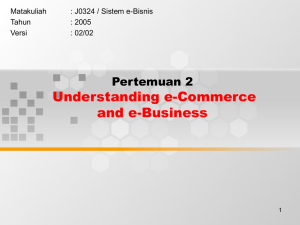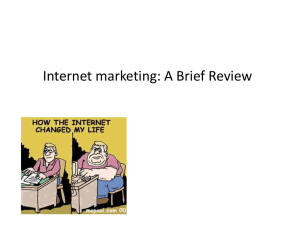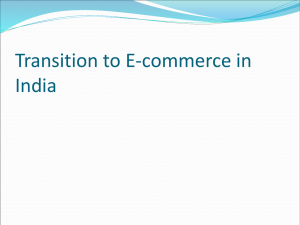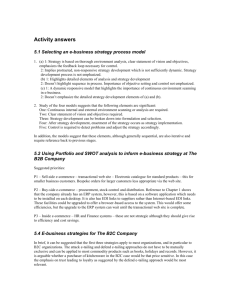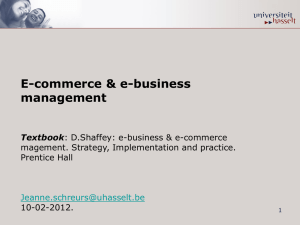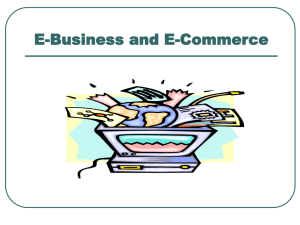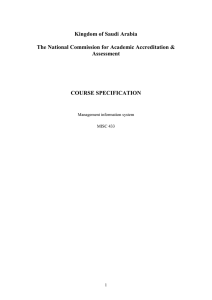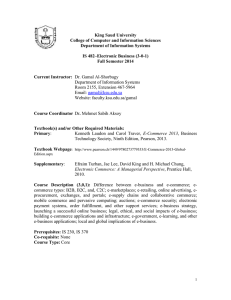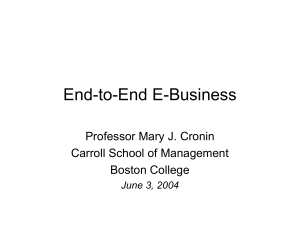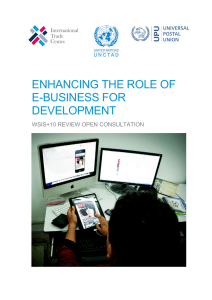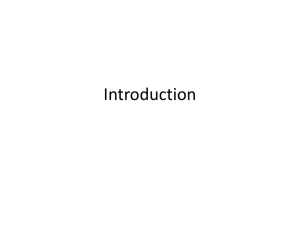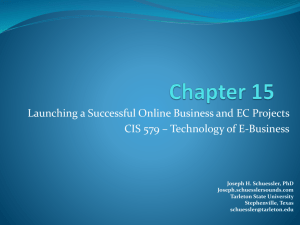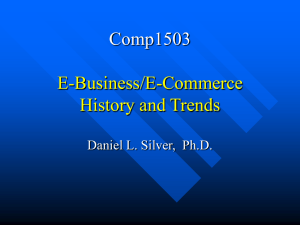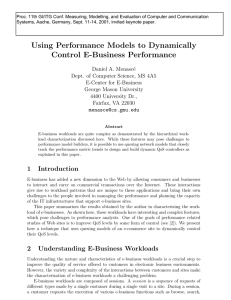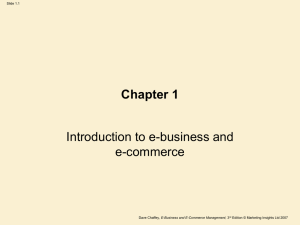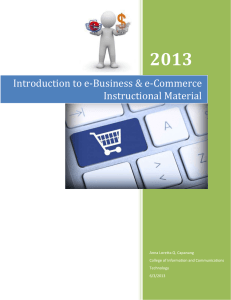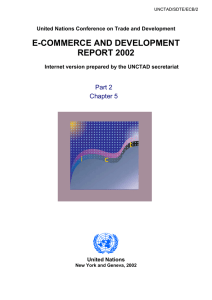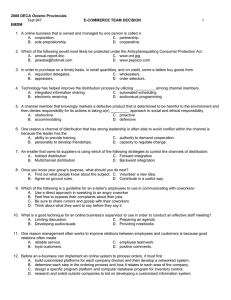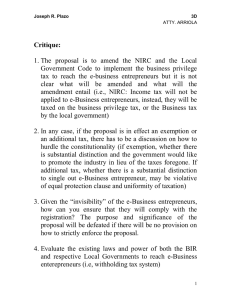E-Commerce Concepts and Application (PPT 254)
advertisement
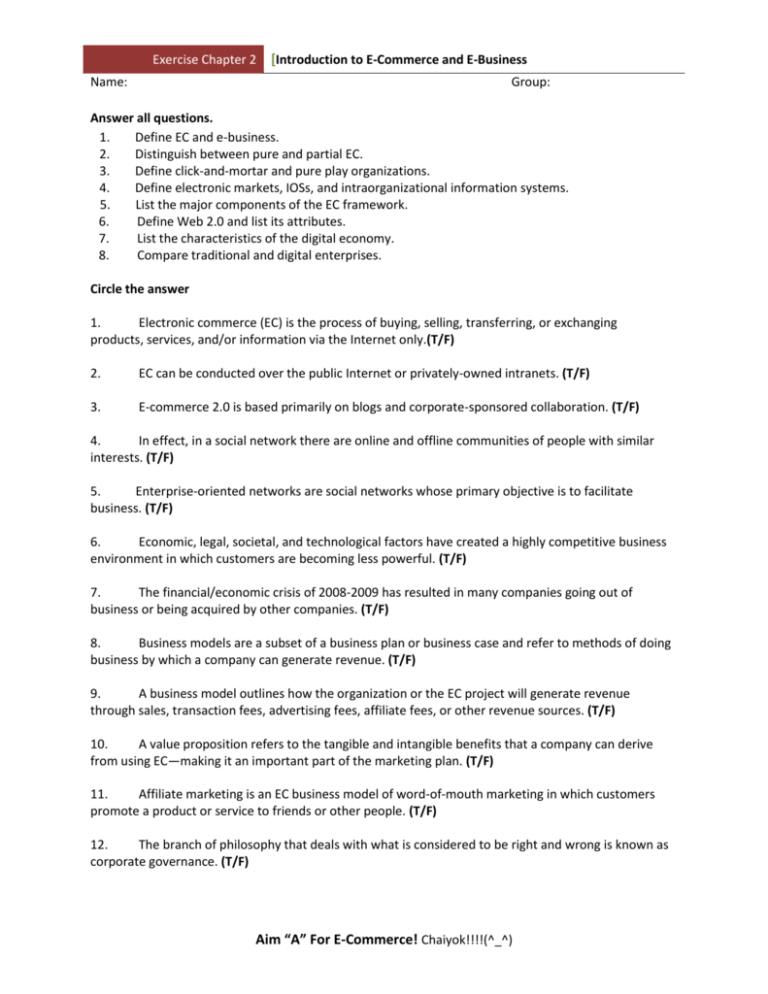
Exercise Chapter 2 Name: [Introduction to E-Commerce and E-Business Group: Answer all questions. 1. Define EC and e-business. 2. Distinguish between pure and partial EC. 3. Define click-and-mortar and pure play organizations. 4. Define electronic markets, IOSs, and intraorganizational information systems. 5. List the major components of the EC framework. 6. Define Web 2.0 and list its attributes. 7. List the characteristics of the digital economy. 8. Compare traditional and digital enterprises. Circle the answer 1. Electronic commerce (EC) is the process of buying, selling, transferring, or exchanging products, services, and/or information via the Internet only.(T/F) 2. EC can be conducted over the public Internet or privately-owned intranets. (T/F) 3. E-commerce 2.0 is based primarily on blogs and corporate-sponsored collaboration. (T/F) 4. In effect, in a social network there are online and offline communities of people with similar interests. (T/F) 5. Enterprise-oriented networks are social networks whose primary objective is to facilitate business. (T/F) 6. Economic, legal, societal, and technological factors have created a highly competitive business environment in which customers are becoming less powerful. (T/F) 7. The financial/economic crisis of 2008-2009 has resulted in many companies going out of business or being acquired by other companies. (T/F) 8. Business models are a subset of a business plan or business case and refer to methods of doing business by which a company can generate revenue. (T/F) 9. A business model outlines how the organization or the EC project will generate revenue through sales, transaction fees, advertising fees, affiliate fees, or other revenue sources. (T/F) 10. A value proposition refers to the tangible and intangible benefits that a company can derive from using EC—making it an important part of the marketing plan. (T/F) 11. Affiliate marketing is an EC business model of word-of-mouth marketing in which customers promote a product or service to friends or other people. (T/F) 12. The branch of philosophy that deals with what is considered to be right and wrong is known as corporate governance. (T/F) Aim “A” For E-Commerce! Chaiyok!!!!(^_^) Exercise Chapter 2 Name: [Introduction to E-Commerce and E-Business Group: Answer all questions. 1. Define EC and e-business. 2. Distinguish between pure and partial EC. 5. Define click-and-mortar and pure play organizations. 6. Define electronic markets, IOSs, and intraorganizational information systems. 7. List the major components of the EC framework. 8. Define Web 2.0 and list its attributes. 9. List the characteristics of the digital economy. 10. Compare traditional and digital enterprises. Circle the answer 1. Electronic commerce (EC) is the process of buying, selling, transferring, or exchanging products, services, and/or information via the Internet only.(T/F) 2. EC can be conducted over the public Internet or privately-owned intranets. (T/F) 3. E-commerce 2.0 is based primarily on blogs and corporate-sponsored collaboration. (T/F) 4. In effect, in a social network there are online and offline communities of people with similar interests. (T/F) 5. Enterprise-oriented networks are social networks whose primary objective is to facilitate business. (T/F) 6. Economic, legal, societal, and technological factors have created a highly competitive business environment in which customers are becoming less powerful. (T/F) 7. The financial/economic crisis of 2008-2009 has resulted in many companies going out of business or being acquired by other companies. (T/F) 8. Business models are a subset of a business plan or business case and refer to methods of doing business by which a company can generate revenue. (T/F) 9. A business model outlines how the organization or the EC project will generate revenue through sales, transaction fees, advertising fees, affiliate fees, or other revenue sources. (T/F) 10. A value proposition refers to the tangible and intangible benefits that a company can derive from using EC—making it an important part of the marketing plan. (T/F) 11. Affiliate marketing is an EC business model of word-of-mouth marketing in which customers promote a product or service to friends or other people. (T/F) 12. The branch of philosophy that deals with what is considered to be right and wrong is known as corporate governance. (T/F) Aim “A” For E-Commerce! Chaiyok!!!!(^_^)

